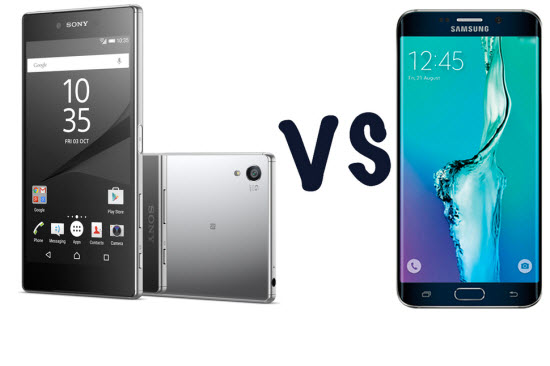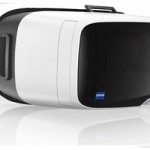Sony has just announced three new flagship devices including the Xperia Z5 Premium, the Xperia Z5 and the Xperia Z5 Compact. While the Xperia Z5 is the leader of the pack and the device will bring a 4K display to the powerful world of smartphones. The following article will make a comparison of Sony Xperia Z5 with Samsung’s recently unveilled Galaxy S6 Edge Plus in the area of screens, design, power, OS, cameras and battery life.

Screen
The Galaxy S6 Edge gives us beautiful dual curved screens on a 5.7-inch display. Add to that Samsung’s excellent Super AMOLED technology, which really makes it a pop and a QHD resolution of 1440 x2560. While the Sony Xperia Z5 Premium is a touch smaller that the S6 Edge Plus, but its 4K resolution makes it the first smartphone in the world to rock the 3840 x 2160 statistics. The 4K resolution gives you an incredible pixel density of 806ppi, which easily tops an already impressive 518ppi on the Galaxy S6 Edge+. The Xperia Z5 will be arrow sharp, while the S6 Edge+ will likely be brighter and more colourful. Either way, these are two of the best smartphone screens around.
Design
The Galaxy S6 Edge Plus may be slender at just 6.9mm thick and surprisingly lightweight for a phone of its size at 153g, but the 154.4 x 75.8mm height and width means the S6 Edge+ will be a noticeable force in your hand and pocket.
While Sony is sticking with its Omnibalance design, with a familiar industrial look returning with the Xperia Z5 Premium. That is a notable change however, with the distinctive oversize circular home button on the side getting replaced with an oval, flag key.
Not to be outdone in the dimension war the Z5 Premium is a relatively svelte 7.8mm, but considering it has a smaller screen than the Samsung it sports the same 154.4 x 75.8mm dimensions. It’s also heavier at 180g, but the trade-off is worth it for the dust-tight and waterproof finish.
Power
The Sony Xperia Z5 Premium It is powered by a Qualcomm MSM8994 Snapdragon 810 chipset with quad-core 1.5 GHz Cortex-A53 and quad-core 2 GHz Cortex-A57 processor, and an Adreno 430 graphic processor under the hood. It also has 3 GB of RAM with a built-in 32 GB memory that can be expanded using the microSD slot.
While the Samsung Galaxy S6 Edge is equipped with an Exynos 7420 chipset and quad-core 1.5 GHz Cortex-A53 or quad-core 2.1 GHz Cortex-A57 processor, as well as Mali-T760MP8. It also has 4 GB of RAM with an option of 32 GB or 64 GB internal memory capacity.
OS and interface
Both handsets come running Android 5.1 Lollipop, the latest release from Google, ensuring you get top notch software. Expect both to get updates to Android Marshmallow once it launches, although it’ll take a few months before it’s pushed out.
The Samsung Galaxy S6 Edge+ sports the firm’s TouchWiz interface which has been greatly refined in 2016 making it more pleasing to use than previous iterations. Samsung has done away with a lot of the bloatware and smartened up menu screens making the S6 Edge+ easier to use.
Sony has applied its own skin to the Xperia Z5 Premium with a finish which is closer to that of Google’s stock Android. There are a few handy additional features, but for those moving from other Android handsets the Sony should be the easier to learn.
Cameras
Ever since the launch of the Sony Xperia Z1, Sony has made a point of marketing the camera on its Xperia Z smartphones. Up until the Xperia Z5 range, there has been a 20.7-megapixel sensor on board, which has now been increased to a 23-megapixel sensor for the rear, along with a 5-megaixel snapper on the front.
The Samsung Galaxy S6 edge Plus has a 16-megapixel rear snapper and a 5-megapixel front snapper, bringing the same technologies from its Galaxy S6 and Galaxy S6 edge siblings, both of which were highly acclaimed for their camera capabilities.
Sony has a tough battle to fight with the camera, but it does win on megapixels here and with the super fast 0.03-second auto focus system, the improvement to image stabilisation and the claim of a clear image even at 5x zoom, it looks like Samsung could have a great contender to watch out for.
Battery life
With such big screens there is a fear for battery life in the two phablets. Neither have removable power packs, so you’ll be relying on the battery inside to at least see out a full day before requiring a re-charge.
The Samsung Galaxy S6 Edge+ comes with a 3000mAh battery. It’s not the largest around but it’s acceptable and the addition of wireless charging means it’s easier to top up. It also has fast charging, allowing you to get a slug of charge after just a few minutes.
There’s a bigger 3430mAh battery in the Sony Xperia Z5 Premium, but it’s having to power a 4K display which will be very hungry. There’s no wireless charging, but there is a Stamina mode to help you eke the last drops from it when you’re running low.
Conclusion:
There’s no doubt about it, both the Samsung Galaxy S6 Edge+ and Sony Xperia Z5 Premium are packed full of features. The screens are stunning, the power plentiful and the cameras cracking.
If you’re on the hunt for a new phablet in your life then these two definitely need to be considered. They’re not cheap, but you’re getting an awful lot of bang for your buck.
Transfer and play media files on Sony Xperia Z5 Premium
The big screen size together with the light weight body make Sony Xperia Z5 Premium and S6 Edge Plus a ideal solution for watching movies on the move. However, both the two smartphones have support for very limited video file formats playback, to fix this issue, you can free download Pavtube Video Converter for Windows/Mac which is capable of converting various different file formats including Blu-ray/DVD/MKV/MXF/Tivo/FLV, etc to Sony Xperia Z5 Premium and Galaxy S6 Edge readable file formats on both Windows and Mac.











